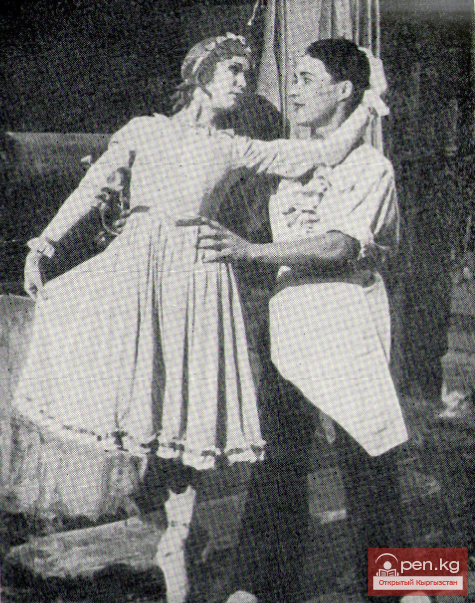
The First Steps Towards Professional Kyrgyz Ballet
Folk dances, based on elements of rituals and games, determined the direction in which the initial development of national choreography took place, which found its expression in the musical-dramatic performances of the Kyrgyz theater.
However, the further success of Kyrgyz choreography is linked to the mastery of classical dance. Therefore, the ballet group of the Kyrgyz Musical Theater, alongside their work on national dance, began to learn the basics of classical ballet. To this end, in the autumn of 1939, the classical ballet "The Rivals" by P. Hertel was staged, based on the well-known comic ballet "The False Precaution" by Jean Dauberval. The libretto was authored by the famous directors of the Moscow Art Theater B. Mordvinov, P. Markov, and the then-young choreographer N. S. Kholfin. In the early 1930s, this ballet was staged by the troupe of the Moscow Artistic Ballet, led by Viktorina Krieger. The staging of P. Hertel's ballet on the Moscow stage was of fundamental importance and was "a practical application of the principles of the Moscow Art Theater in ballet art." This was primarily reflected in the fact that it was not enough for the actor to demonstrate technique; the dance had to reveal the inner content of the character. The dramatic foundation of the performance was prioritized.
The plot can be summarized as follows. The landowner Marcelina (the action takes place in France) gathers guests for the engagement of her daughter Liza to the son of a wealthy landowner, Misho—Nikes. However, young Liza is fond of the gardener Kolen, who is loved by the maid, also named Liza. After many comedic situations, the wedding of the landowner's daughter and Nikes falls through, while the maid Liza completely wins over Kolen.
The performance had a distinctly comedic character. The natural talent of Dzhuken Jabieva shone through in the role of the maid Liza. The lightness of her dance corresponded to the character of the lively, cheerful heroine. She created a warm, charming image. Later, this role was performed by another remarkable ballerina—D. Arsygulova. Bright characters in this performance were created by the honored artist of the republic A. Aibashev (Misho), K. Kozubekov (Nikes' servant), O. Kurmanbekov, A. Moldobaeva (peasants), and others.
The ballet "The Rivals" ran for a long time in the theater. The cast changed (R. Aydralieva, G. Khudaibergenova, Z. Shakhvorostova, Sh. Gafarov, S. Kabekov, A. Mamakeev, L. Alyas, G. Daniyarova, S. Baybatyrov, Yu. Kuldarova, etc.), and for each of the young artists, the performance was a good practical school on the path to mastering their craft.
The "Rivals" in the young Kyrgyz theater was staged by N. S. Kholfin—one of the authors of the performance of the Moscow Artistic Ballet. Together with the educators of the Kyrgyz theater Yu. V. Mikhalev and V. M. Bakitko, N. S. Kholfin brought realistic Moscow Art Theater principles to the Kyrgyz theater. It is particularly important to note this, as it was a period of learning, and the principles that were introduced into the creative system of the theater determined its future. Fortunately for the Kyrgyz theater, it was from the very beginning aligned with realism. This was primarily due to the figures of Russian art who did everything to prevent the young theater from being overwhelmed by the influence of formalism.
The staging of "The Rivals" is difficult to overestimate. At a time when practical professional skills in ballet art were being solidified, the young actors came into contact with wonderful music and solid dramatic material.
Of course, it cannot be said that the staging of "The Rivals" was at a high choreographic level. It can largely be called a student work. It is enough to say that the work on the performance involved mastering such a fundamental aspect of ballet dance as movement on pointe. But the learning was conducted on quality material, and this ensured the technical improvement of the young artists of the Kyrgyz ballet. On the other hand, in the words of choreographer V. Kozlov, this performance "served as the springboard from which the ballet company would create the first national Kyrgyz ballet." And it was soon born—the first Kyrgyz ballet "Anar".
The First Kyrgyz Dances on the Professional Stage